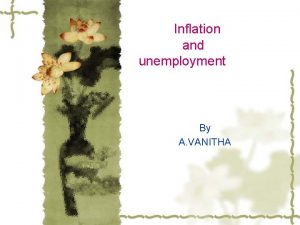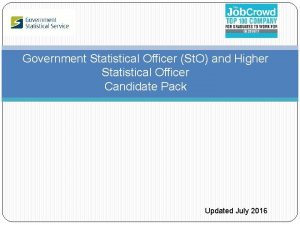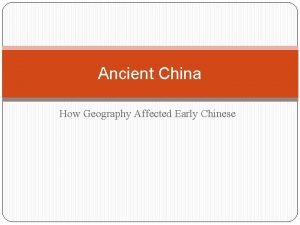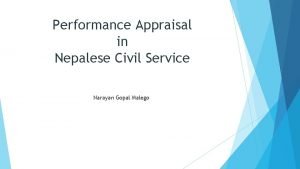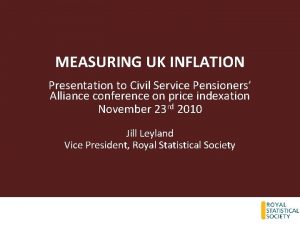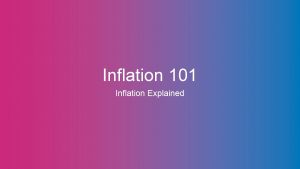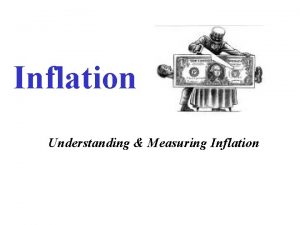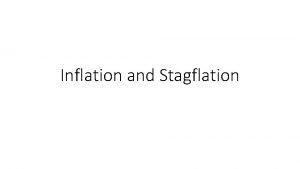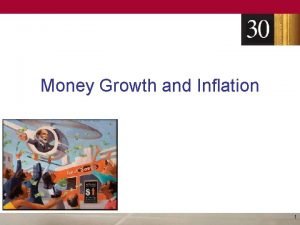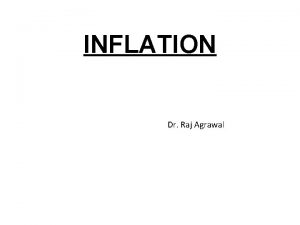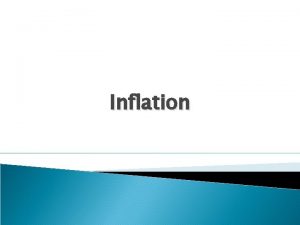MEASURING UK INFLATION Presentation to Civil Service Pensioners
















- Slides: 16

MEASURING UK INFLATION Presentation to Civil Service Pensioners’ Alliance conference on price indexation November 23 rd 2010 Jill Leyland Vice President, Royal Statistical Society

Key points • Compiling price indices difficult and controversial • UK Consumer Price Index does not have appropriate coverage for inflation uplift measure but • Retail Price Index methodology looks questionable; probably overstates inflation • What needs to be done

Measuring inflation often controversial – in any country • People have different spending patterns – so different inflation experiences • Notice price rises more than price falls • Conceptual problems • Methodological issues – no single “right” way of compiling index numbers and – different approaches give different results

Conceptual problems • • Owner-occupied housing Taxation Quality changes Movement in prices vs “cost of living”

Constructing an index 1) Decide: – what items to include and their weight in the overall basket – base period (set as 100) 2) For each item: – collect prices from different outlets every month – calculate “average” % increase (or decrease) between base period and current month (calculation step 1) 3) Calculate weighted “average” percentage increase (decrease) for ALL items – (calculation step 2) But. . .

How to calculate the “average”? Many methods – choice a matter of judgement. Most common for indices: – Arithmetic mean (two variations): add up the n items and divide by n – Geometric mean: Multiply the n items together and take nth root of the result Key point: assumption about degree to which people switch to lower priced items

In the UK • Two different indices: • Consumer price index – originally called the Harmonised Index of Consumer Prices (HICP) • Retail price index – long standing and familiar

Consumer price index • Harmonised index to measure inflation in EU countries on comparable basis • Owner occupied housing left out; no agreement on treatment • Based on economic concepts… – Council tax, vehicle excise duty, TV licences, trade union dues left out – Low weight for insurance – Spending by overseas visitors included • Geometric mean at calculation step 1

UK unusual name change • Originally called Harmonised Index of Consumer Prices (HICP) • Name changed in UK in 2003 when made inflation target • UK unusual in doing this. Other countries call it HICP and use CPI for their main index

CPI • Fine for macroeconomic purposes (eg inflation targeting, international comparisons) • But coverage not suitable for other uses including wage negotiations, pensions/benefits uplift etc • Geometric mean at step 1 assumes some degree of switching to lower priced items

RPI • Covers most items in household budget inc mortgage payments; excludes some households • Uses arithmetic mean at step 1. – Assumes no switching to cheaper versions of same item – And for many items a form of arithmetic mean which tends to show higher inflation • Therefore probably overstates inflation Major changes to formula difficult due to index linked bond issue

Differences: it’s not just housing • Treatment of owner occupier housing one difference but also others • Exclusion of other items from CPI, certain households from RPI • And the “formula effect” – impact of use of different means in calculation step 1 • Formula effect difference very important and always in the same direction so RPI will grow faster than CPI

And the difference is: Reduction in interest rates during crisis

But adjusting formula effect NB: rough and ready adjustment

What needs to be done • ONS must pay attention to all uses of price indices not just macroeconomic ones • In short term “CPI plus” should be created with coverage adjustments; different indices for different household groups • In longer term proper assessment of extent to which consumers switch to lower priced items; appropriate index treatment for different items selected • Where possible improvements made to RPI methodology

Users must make their voice heard • Directly: ONS very willing to listen, about to carry out consultation on CPI/RPI but • Don’t always hear from users outside central government And also Statistics User Forum: – organisation for users (auspices of RSS, supported by ESRC and UK Statistics Authority) – developing full user engagement website – Interim site at http: //sufenews. org. uk/ or email suf@rss. org. uk
 Group mediclaim policy presentation
Group mediclaim policy presentation Types of unemployment
Types of unemployment Civil rights and civil liberties webquest
Civil rights and civil liberties webquest Daniel gerson oecd
Daniel gerson oecd Gss competency framework
Gss competency framework Heo job description
Heo job description Civil service competency examples
Civil service competency examples Civil service of ancient han
Civil service of ancient han Chapter 15 section 3 politics in the gilded age
Chapter 15 section 3 politics in the gilded age Cfcd civil service
Cfcd civil service Dan sexton civil service
Dan sexton civil service Civil service talent management
Civil service talent management Civil service performance appraisal examples
Civil service performance appraisal examples Civil service han dynasty
Civil service han dynasty Civil service fast stream competencies
Civil service fast stream competencies Civil service club bristol
Civil service club bristol Scope of bureaucracy
Scope of bureaucracy

